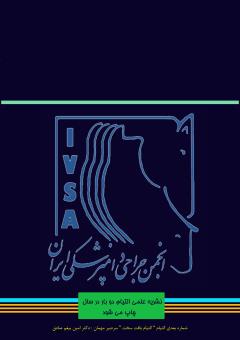Acquried tendon injuries in cattle
Subject Areas : Veterinary Soft and Hard Tissue Surgery
Zahra Sadat Yousef Sani
1
,
Ahad Jafari Rahbar Alizadeh
2
,
Samaneh Ghasemi
3
*
![]()
1 - Department of Clinical Science, Faculty of Veterinary Medicine, Ferdowsi University of Mashhad, Iran
2 - Department of Clinical Science, Faculty of Veterinary Medicine, Ferdowsi University of Mashhad, Iran
3 -
Keywords: Cattle, Tendon, Tendon injuries, Lameness, Tenosynovitis,
Abstract :
Tendon disorders are the important cause of lameness, decreased production and loss of economic in cattle. These disorders may be congenital or acquired. Acquired tendon injuries involve tendon laceration, avulsion and rupture. Direct trauma, breeding injuries, bulls fight, and, handling accidents are the most causes of tendon injuries in cattle. Deep and superficial digital flexor tendons and gastrocnemius tendon are commonly affected. Clinical signs of tendon injuries depend on the severity of injury. Pain, mild to severe lameness and recumbency are the clinical signs associated with tendon injuries in cattle. Treatment of tendon injuries consist of stall confinement, anti-inflammatory medications, limb supporting through application of cast or splint and tenorrhaphy. The prognosis of tendon injuries affects by the severity of injury. Common acquired tendon injuries in cattle are described in this article.
1. Goodship AE, Birch HL. The pathology of acute and chronic tendon injury. Vet Clin North Am Equine Pract. 2003;19(3):687-701.
2. Anderson DE, Jean GS. Diagnosis and management of tendon disorders in cattle. Vet Clin North Am Food Anim Pract 1996;12(1):85-116.
3. Simpson S, et al. Tendon injuries in sport: a review on the rising incidence, pathogenesis, and treatment. Asian J Sports Med. 2017;8(2):e30634.
4. Curtis AJ, et al. Tendon injury in horses and cattle. Vet Clin North Am Food Anim Pract 2018;34(2):317-331.
5. McIlwraith CW, et al. Joint disease research in veterinary medicine. Am J Pathol 2016;186(3):719-727.
6. Orsini JA, Grenager NS, DeLahunta A. Comparative veterinary anatomy: a clinical approach. 2021;1:1215.
7. Nuss K, Boppart J, Geyer H. Clinical findings, treatment, and outcome in 11 dairy heifers with breakdown injury due to interosseous medius muscle rupture. Vet Surg 2017;46(2):197-205.
8. Muir P. Peroneus tertius tendinitis in a cow. Vet Rec. 1993;132(23):576.
9. Steiner A, Anderson D.E, Desrochers A, Diseases of the tendons and tendon sheaths. Vet Clin North Am Food Anim Pract. 2014 Mar;30(1):157-175
10. Anderson D.E, Desrochers A, Jean G, Management of Tendon Disorders in Cattle. Vet Clin North Am Food Anim Pract 2008;24(3):551-66.
11. Smith BP. Large Animal Internal Medicine. Fifth ed. St. Louis Missouri: Elsevier Mosby; 2015.
12. Anderson DE, St-Jean G, Morin DE, et al. Traumatic flexor tendon injuries in 27 cattle. Vet Surg 1996;25(4):320-326.
13. Wilson DG, Vanderby R Jr. An evaluation of fiberglass cast application techniques. Vet Surg 1995;24(2):118-121.
14. Wilson DG, Vanderby R Jr. An evaluation of six synthetic casting materials: strength of cylinders in bending. Vet Surg 1995;24(1):55-59.
15. Easley KJ, Stashak TS, Smith FW, et al. Mechanical properties of four suture patterns for transected equine tendon repair. Vet Surg 1990;19(2):102-106.
16. Everett E, Barrett JG, Morelli J, et al. Biomechanical testing of a novel suture pattern for repair of equine tendon lacerations. Vet Surg 2012;41(2):278-285.
17. Bertagnoli A, Raber M, Morandi N, et al. Tenovaginoscopic approach to the common digital flexor tendon sheath of adult cattle: technique, normal findings and preliminary results in four clinical cases. Vet J 2012;191(1):121-127.
18. Stanek C. Septic tenosynovitis of the digital flexor tendon sheath. In: Greenough P, editor. Lameness in cattle, vol. 1, 3rd edition. Philadelphia, London, Toronto, Montreal (Canada), Sydney (Australia), Tokyo: WB Saunders; 1997. p. 188-190.
19. Barza M, Samuelson T, Weinstein L. Penetration of antibiotics into fibrin loci in vivo. II. Comparison of nine antibiotics: effect of dose and degree of protein binding. J Infect Dis 1974;129(1):66-72.

